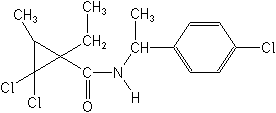-
Common NameCarpropamid
-
中文通用名环丙酰亚胺
-
IUPACa mixture of (1R,3S)-2,2-dichloro-N-[(R)-1-(4-chlorophenyl)ethyl]-1-ethyl-3-methylcyclopropanecarboxamide, (1S,3R)-2,2-dichloro-N-[(R)-1-(4-chlorophenyl)ethyl]-1-ethyl-3-methylcyclopropanecarboxamide, (1S,3R)-2,2-dichloro-N-[(S)-1-(4-chlorophenyl)ethyl]-1-ethyl-3-methylcyclopropanecarboxamide and (1R,3S)-2,2-dichloro-N-[(S)-1-(4-chlorophenyl)ethyl]-1-ethyl-3-methylcyclopropanecarboxamide where the first two cited comprise at least 95% of the total
-
CAS2,2-dichloro-N-[1-(4-chlorophenyl)ethyl]-1-ethyl-3-methylcyclopropanecarboxamide
-
CAS No.104030-54-8
-
Molecular FormulaC15H18Cl3NO
-
Molecular Structure
-
Category
-
ActivityFungicide.
Carpropamid is active against the deuteromycete fungus, Pyricularia oryzae. The compound inhibits melanin biosynthesis in appressorium cells via a different mechanism from other known inhibitors; carpropamid acts at the dehydration steps of the biochemical pathway rather than the reduction steps. It is suggested that carpropamid also induces disease resistance in rice plants through enhanced production of phytoalexins such as momilactone A and sakuranetin.
Carpropamid is a systemic fungicide absorbed by roots and leaves with a long period of residual activity. A paper on the uptake and translocation of carpropamid (Pesticide Management Science, 2001) reports that carpropamid can be exuded from the leaf surface following seed treatment; of the applied radiolabel located in the leaves, 27% was present on the surface and it is probably this material that is responsible for the fungal anti-penetrant activity of the product. Following seed treatment, 8.3% of applied radiolabel was recoverable in 21 day old seedlings. Carpropamid is readily absorbed via the roots of young rice seedlings and is then translocated, mainly in the apoplast, to all parts of the seedling. Application to leaves results in a small (2% of applied radiolabel) amount of translocation into the plant.
Unlike existing rice blast fungicides, carpropamid used as a granule treatment can control both leaf and panicle blast with one application to seedling boxes. Foliar treatments must be made at the outbreak of disease and seven days later for leaf blast, and at booting and heading for panicle blast. Carpropamid is not phytotoxic to rice and can be applied by seed dressing in both transplanted and direct-seeded cultivation practices.
In field trials, carpropamid gave equal or better control of P oryzae than standard blast fungicides with lower application rates.
Nursery box treatments can provide ‘one-shot’ season-long control of leaf and panicle blast, remaining in the soil layers around the roots for an extended period; its low water solubility reduces the potential to enter paddy field irrigation water sources.
Application of granular formulations of carpropamid and its combination products reduces the labour requirement in nursery box cultivations and removes the need for two later spray applications of other products. Bayer reports that the introduction of carpropamid-based products as long-lasting seed dressings has encouraged the transition from cultivation of transplanted rice to direct-sown rice in Korea. -
CropUseCrop uses:
Rice
200-400 g ai/ha (nursery boxes)
75-150 g ai/ha (foliar treatment)
160 g ai/ha (seed treatment)
-
Premix
Type
AI concn
Suspension concentrate (SC)
15% (w/v)
30% (w/v)sc
Granules (GR)
2% and 4% (w/w)
Water-dispersible granule (WG)
40% (w/v) under development
Flowable concentrate(FS)
30% (w/v)
-
Physical PropertiesMolecular weight:334.7; Physical form:Colourless crystals; (tech. is a white to yellowish powder). Density:1.17 (20 °C); Composition:Diastereoisomeric mixture (A:B c. 1:1; RS c. 95:5); the (1R,3S,1R)- enantiomer is designated AR, the (1S,3R,1R)- enantiomer BR. Melting point:147-149 °C; Vapour pressure:AR: 2×10-3 mPa; BR: 3×10-3 mPa (both 20 °C, gas saturation method OECD 104); Henry constant:AR: 4×10-4 Pa m3 mol-1, BR: 5×10-4 Pa m3 mol-1 (both 20 °C, calc.); Partition coefficient(n-octanol and water):AR: logP = 4.23, BR: logP = 4.28 (both 22 °C); Solubility:In water 1.7 (AR), 1.9 (BR) (both in mg/l, pH 7, 20 °C).;
-
ToxicologyOral:Acute oral LD50 for male and female rats >5000, male and female mice >5000 mg/kg. Percutaneous:Acute percutaneous LD50 for male and female rats >5000 mg/kg. No eye or skin irritation (rabbits); not a skin sensitiser (guinea pigs). Inhalation: LC50 for male and female rats >5000 mg/m3 (dust). ADI:0.03 mg/kg (proposed).?
-
Environmental ProfileEcotoxicology:?
Algae:ErC50 (72 h) for Scenedesmus subspicatus >2 mg/l.Birds:LD50 for Japanese quail >2000 mg/kg.Daphnia:LC50 (3 h) 410 mg/l.Fish:LC50 (48/72 h) for carp 5.6 mg/l; LC50 (96 h) for rainbow trout 10 mg/l.Worms: LC50 for Eisenia foetida >1000 mg/kg dry substrate.Other aquatic spp.:LC50 (3 h) for water flea (Moina macrocopa) >20 mg/l.?
Environmental fate:?
Animals:After oral administration of radiolabelled carpropamid to rats, the radioactivity was readily excreted via faeces and urine. Carpropamid was metabolised oxidatively, mainly in the liver.Soil:Carpropamid was metabolised oxidatively under paddy soil conditions; CO2 was the major metabolite. In field and laboratory trials, under paddy conditions, the calculated half-lives ranged from several weeks to several months, respy. Plant:After treatment of rice plants via soil (nursery box application) or nutrient medium, carpropamid was absorbed by the roots and translocated to the shoots. The major residue in rice was carpropamid.
Carp [48 h]
LC50 5.6 mg/L
Daphnia[3 h]
LC50 >20 mg/L
Daphnia[48 h]
LC50 >1 mg/L
-
Transport InformationHazard Class:III (Slightly hazardous)
Porduct NewsMore
Orthosulfamuron boosts sugarcane production, study finds
Glyphosate price plummets 40% in one year in Argentina
Indian govt stops imports of herbicide Glufosinate priced below Rs 1,289 per kg
Carbendazim fungicide wins victory in Brazilian Parliament
Corteva presents new pre-emergent herbicide Linear for sugarcane in Brazil
Picloram Triclopyr Aminopyralid
Revolutionizing disease prevention: BASF launches new rice fungicide Cevya® in China
Thiamethoxam is allowed again in Brazil by a judicial decision
Bayer develops alternative to glyphosate herbicide

 0
0 Subscribe
Subscribe
